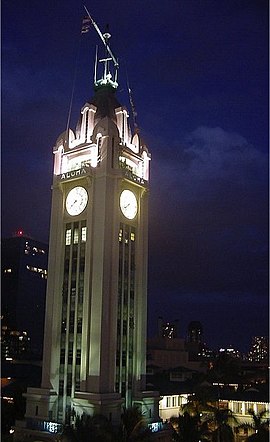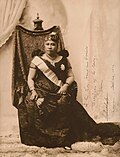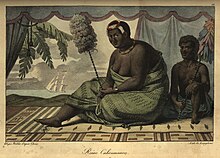The Hawaii Portal Hawaii (/həˈwaɪ.i/ hə-WY-ee; Hawaiian: Hawaiʻi [həˈvɐjʔi, həˈwɐjʔi]) is an island state of the United States, in the Pacific Ocean about 2,000 miles (3,200 km) southwest of the U.S. mainland. It is the only state not on the North American mainland, the only state that is an archipelago, and the only state in the tropics. Hawaii consists of 137 volcanic islands that comprise almost the entire Hawaiian archipelago (the exception, which is outside the state, is Midway Atoll). Spanning 1,500 miles (2,400 km), the state is physiographically and ethnologically part of the Polynesian subregion of Oceania. Hawaii's ocean coastline is consequently the fourth-longest in the U.S., at about 750 miles (1,210 km). The eight main islands, from northwest to southeast, are Niʻihau, Kauaʻi, Oʻahu, Molokaʻi, Lānaʻi, Kahoʻolawe, Maui, and Hawaiʻi, after which the state is named; the latter is often called the "Big Island" or "Hawaii Island" to avoid confusion with the state or archipelago. The uninhabited Northwestern Hawaiian Islands make up most of the Papahānaumokuākea Marine National Monument, the largest protected area in the U.S. and the fourth-largest in the world. Of the 50 U.S. states, Hawaii is the eighth-smallest in land area and the 11th-least populous; but with 1.4 million residents, it ranks 13th in population density. Two-thirds of Hawaii residents live on O'ahu, home to the state's capital and largest city, Honolulu. Hawaii is among the country's most diverse states, owing to its central location in the Pacific and over two centuries of migration. As one of only six majority-minority states, it has the only Asian American plurality, the largest Buddhist community, and largest proportion of multiracial people in the U.S. Consequently, Hawaii is a unique melting pot of North American and East Asian cultures, in addition to its indigenous Hawaiian heritage. Settled by Polynesians sometime between 1000 and 1200 CE, Hawaii was home to numerous independent chiefdoms. In 1778, British explorer James Cook was the first known non-Polynesian to arrive at the archipelago; early British influence is reflected in the state flag, which bears a Union Jack. An influx of European and American explorers, traders, and whalers soon arrived, leading to the decimation of the once-isolated indigenous community through the introduction of diseases such as syphilis, tuberculosis, smallpox, and measles; the native Hawaiian population declined from between 300,000 and one million to less than 40,000 by 1890. Hawaii became a unified, internationally recognized kingdom in 1810, remaining independent until American and European businessmen overthrew the monarchy in 1893; this led to annexation by the U.S. in 1898. As a strategically valuable U.S. territory, Hawaii was attacked by Japan on December 7, 1941, which brought it global and historical significance, and contributed to America's entry into World War II. Hawaii is the most recent state to join the union, on August 21, 1959. In 1993, the U.S. government formally apologized for its role in the overthrow of Hawaii's government, which had spurred the Hawaiian sovereignty movement and has led to ongoing efforts to obtain redress for the indigenous population. (Full article...) This is a Featured article, which represents some of the best content on English Wikipedia..
On 9 February 2001, about nine nautical miles (17 km; 10 mi) south of Oahu, Hawaii, in the Pacific Ocean, the United States Navy (USN) Los Angeles-class submarine USS Greeneville (SSN-772) collided with the Japanese fishery high-school training ship Ehime Maru (えひめ丸) from Ehime Prefecture. In a demonstration for some VIP civilian visitors, Greeneville performed an emergency ballast blow surfacing maneuver. As the submarine shot to the surface, she struck Ehime Maru. Within ten minutes of the collision, Ehime Maru sank. Nine of the thirty-five people aboard were killed: four high school students, two teachers, and three crew members. Many Japanese people, including government officials, were concerned by news that civilians were present in Greeneville's control room at the time of the accident. Some expressed anger because of a perception that the submarine did not try to assist Ehime Maru's survivors and that the submarine's captain, Commander Scott Waddle, did not apologize immediately afterwards. The USN conducted a public court of inquiry, blamed Waddle and other members of Greeneville's crew, and dealt non-judicial punishment or administrative disciplinary action to the captain and some crew members. After Waddle had been questioned by the Naval Board of Inquiry, it was decided that a full court-martial would be unnecessary, and he was forced to retire and given an honorable discharge. (Full article...)
This is a Good article, an article that meets a core set of high editorial standards.
Hiram Kahanawai, also known as Hairama Kahanawai, (September 1837 – August 7, 1874) was a member of the Hawaiian nobility who served as a retainer and household steward of King Kamehameha IV and his widow Queen Emma of Hawaiʻi. He married the future Princess Poʻomaikelani, and they joined the court of King Kalākaua after he won the royal election of 1874 against Queen Emma. (Full article...) Selected Picture - 'Ōlelo (Language) -This section is here to highlight some of the most common words of the Hawaiian Language, ʻŌlelo, that are used in everyday conversation amongst locals.
Kamaʻāina
Native-born, one born in a place, host, Lit., land child State Facts
State Symbols:
Selected article -
Kaʻahumanu (March 17, 1768 – June 5, 1832) ("the feathered mantle") was queen consort and acted as regent of the Kingdom of Hawaiʻi as Kuhina Nui. She was the favorite wife of King Kamehameha I and also the most politically powerful, and continued to wield considerable power as co-ruler in the kingdom during reigns of his first two successors. (Full article...)
Did you know? -
Hawaii News
Wikinews Hawaii portal
Quotes - "The people to whom your fathers told of the living God, and taught to call 'Father,' and whom the sons now seek to despoil and destroy, are crying aloud to Him in their time of trouble; and He will keep His promise, and will listen to the voices of His Hawaiian children lamenting for their homes." — Queen Liliʻuokalani On this day...
Related portalsTopicsCategoriesAssociated WikimediaThe following Wikimedia Foundation sister projects provide more on this subject:
SourcesDiscover Wikipedia using portals |























